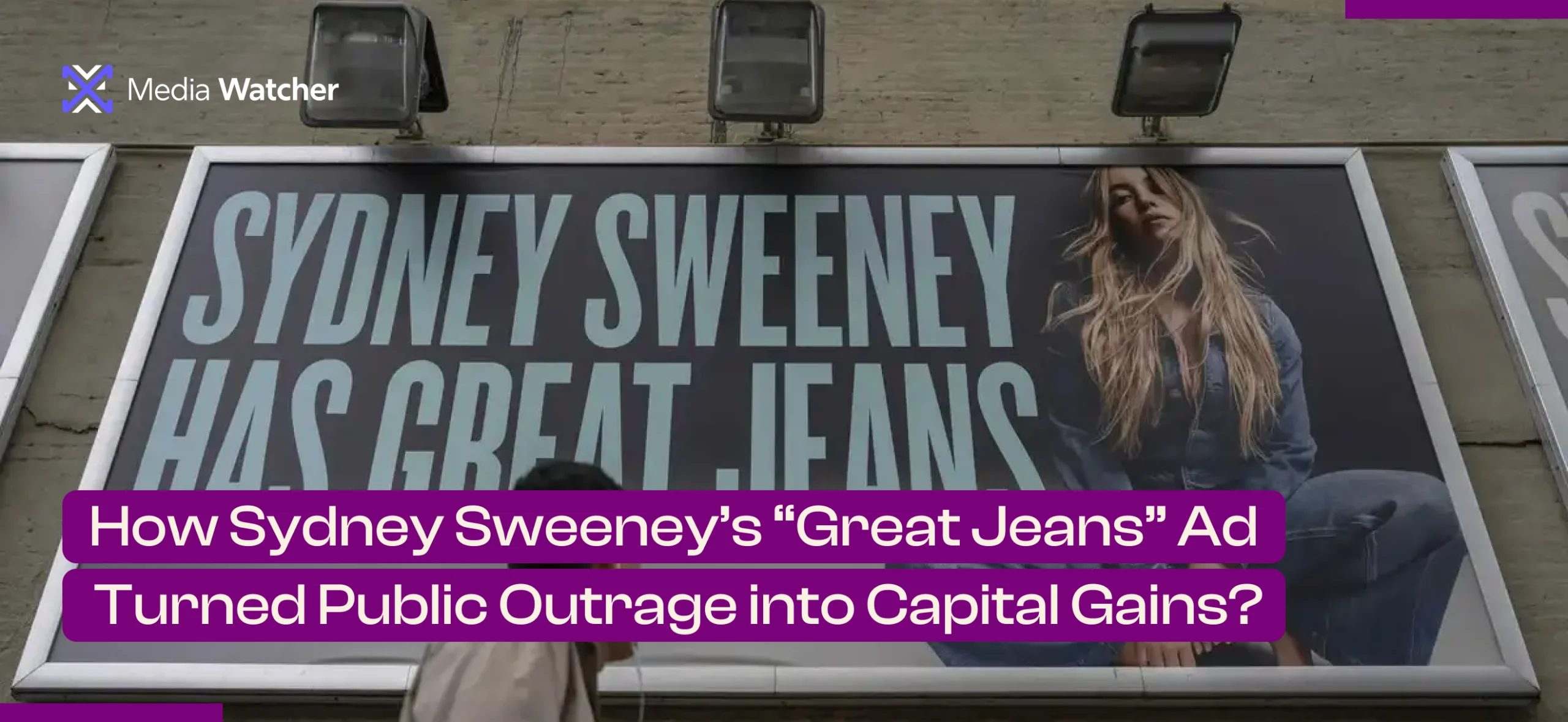When the new fall denim campaign of American Eagle was launched and Sydney Sweeney was featured there, it was constructed on a cheeky pun:
“Sydney Sweeney has great jeans.”
The presentation was immediately caught by the visual pun on genes vs. jeans. In one clip, Sweeney corrects a sign that says “great genes” by crossing it out and writing “jeans.” The double meaning was deliberate and provocative.
The brand was counting on buzz, but what they got was more than just clicks and conversions. It turned into a full-blown cultural moment.
Is It Just an Ad or a Reflection of Toxic Beauty Standards?
The ad was criticised, particularly by the progressive social circles, as tone-deaf. The focus on the blonde hair and blue eyes of Sweeney in the campaign, along with the play on the word genes, was interpreted by others as supporting Eurocentric beauty standards, even making reference to problematic concepts of genetics and superiority.
Articles dubbed it as being beauty idealism in disguise as marketing. Others criticized it as a sort of dog whistle to outmoded standards of beauty.
Concisely, what American Eagle perceived as a brilliant marketing effort was a memory of exclusion for others.
The Brand’s Defense: “It’s About the Jeans”
In response to the criticism, American Eagle posted a simple statement:
“It is and always was about the jeans. Her jeans. Her story. Great jeans look good on everyone.
Their message attempted to shift the discourse back towards fashion, negating any underlying social or political angle. The brand claimed that the campaign was all about self-confidence and style, but not ideals or identity.
Trump Chimes In and the Ad Turns Political
The situation shifted gears when Donald Trump endorsed the Sydney Sweeney jeans ad, citing that it was the “hottest ad out there.” He has, in fact, said, “jeans are flying off the shelves” and that if Sweeney is indeed a Republican, “I think her ad is fantastic.”
The post by Trump transformed a simmering scandal into a political event. In just a few lines, it made the campaign part of the right’s culture war playbook.
Conservative politicians such as JD Vance and Ted Cruz did the same, and they positioned the backlash as another instance of woke overreach.
Sydney Sweeney’s Political Status and the Internet’s Reaction
Soon after this, Sydney Sweeney Republican voter registration surfaced online, adding fuel to the debate. This shifted public perception, with the right rallying behind her and the campaign, while some on the left expressed dismay or disengagement.
Even the actress herself kept quiet during the storm, avoiding being on both sides of applause and criticism, as commercial brands usually like to maintain appeal across boundaries.
How the Campaign Moved the Market Towards High Shares?
After a Trump endorsement and viral debate, the stock of American Eagle shot up over 24% in a single day and closed up at over 13.20$ per share, its largest one-day gain since 2000.
Causes of stock surges:
- The meme stock phenomenon, which was fueled by internet virality and FOMO.
- Retail traders, fired up by the Trump remark, jumped into AEO shares.
- Hypothesis of an increase in sales due to viral marketing of the campaign.
In the face of prior financial problems (including a 5% decrease in Q1 sales and inventory write-offs), the company temporarily flipped the narrative from struggle to success.
Decoding the Complete Consumer Journey on Sydney Sweeney Jeans Ad Controversy
When it comes to figuring out what actually went down here, we need to move beyond the social media bubble and enter the realm of actual consumer behavior. According to a recent data review, the average consumer did not even perceive political messaging in the advertisement.
And here is what the consumer journey was:
1. Initial Awareness
The marketing reached the proper channels, including Instagram, Snapchat, Times Square banners, and even virtual fitting tests through the use of AR. The results led to a New denim drop with Sydney Sweeney, advertising controversy. That was enough to evoke curiosity.
2. Emotional Response
While Twitter and LinkedIn lit up with think pieces, most consumers simply thought:
- “These jeans look great.”
- “That’s Sydney Sweeney, she looks cool.”
- “Might try these on.”
The core response wasn’t outrage; it was interest.
3. Purchase Intent
Actual data indicate that the ad recall was high, particularly among Gen Z and younger Millennials. The connection between a well-known celebrity and a recognizable retailer brought traction.
Some converted into real purchases, especially after the campaign went viral.
4. Virality As a Reinforcement
The unexpected staying power of the ad was given by the political drama. Regardless of whether they found it sexy, problematic, or daring, they continued to see it. This repetition ensured the brand was consolidated in the mind of the consumer, regardless of their political participation.
The Real Lesson: Buyers Choose, not Critics
Perhaps the best lesson that can be drawn out of this saga is that itself, which is a lesson in marketing philosophy:
“It is not the market, you are.”
The most vocal voices of critics, marketers, or influencers are not necessarily representative of what the average consumer believes is right. Semiotics is not what most individuals read into jeans advertisements. They are voting on which appearance is good enough to purchase.
Real-life buyers were proven with the Sydney Sweeney American Eagle ad:
- Everybody does not think the same.
- Have more of an aesthetic than ideology.
- They respond best to messaging that seems contemporary with it, even controversial.
Final Takes
Not all consumers desire that their denim be a matter of debate, but all brands aim to have their denim sold.
The Sydney Sweeney controversy campaign not only sells the jeans, but it also sells the culture, conversation, and even the capital markets. Planned or unplanned, that is marketing magic of the rarest kind.




